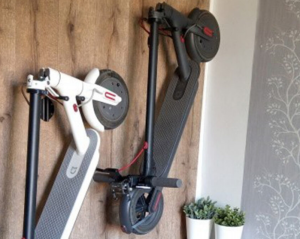Store it indoors, maintain battery charge between 40-70%, keep tires properly inflated, and regularly lubricate moving parts.
Choosing the Right Storage Location
When it comes to storing an electric scooter, selecting the appropriate storage location is paramount for ensuring the scooter’s longevity and performance. The right environment not only safeguards the scooter from the elements but also minimizes the risk of theft and vandalism.
Indoor vs. Outdoor Storage
Indoor storage is the gold standard for electric scooter preservation. Storing your scooter indoors, such as in a garage, shed, or even inside your home, shields it from weather-related wear and tear and temperature fluctuations. An indoor environment offers a stable temperature, which is crucial for battery health. The optimal temperature range for storing electric scooters is between 50°F (10°C) and 77°F (25°C), as extreme cold or heat can significantly degrade the battery’s performance and lifespan.
On the other hand, outdoor storage should be a last resort due to exposure to the elements. If outdoor storage is unavoidable, it is imperative to use a high-quality, waterproof cover that provides UV protection. This setup can offer a modicum of protection against rain, snow, and sun, but it cannot compare to the benefits of indoor storage.
Temperature and Humidity Considerations
Temperature and humidity are critical factors in the preservation of electric scooters. High humidity levels can lead to corrosion of metal components and electrical systems, while excessive dryness might crack rubber parts. Aim to maintain a relative humidity level around 40% to 50% for ideal conditions. Utilizing dehumidifiers or air conditioners in storage areas can help control these environmental variables, ensuring the scooter’s electronic systems and battery remain in peak condition.
Protecting Against Theft and Vandalism
Security is a major concern for electric scooter owners, especially in urban environments where theft and vandalism rates are higher. When storing your scooter indoors, ensure it is in a locked area, such as a garage or a secure building. For added protection, consider using a high-quality lock, even when stored inside. Ground anchors can offer an extra layer of security by physically attaching the scooter to the structure of the building.
For those forced to store their scooters outside, selecting a well-lit, highly visible area can deter potential thieves. Using multiple locks (such as a combination of U-locks and cable locks) can make your scooter a less appealing target for thieves. Always aim to anchor your scooter to a stationary object that cannot be easily tampered with or removed.
Incorporating these detailed considerations into your storage strategy will significantly enhance the protection and preservation of your electric scooter, ensuring it remains safe, secure, and in optimal condition for your next ride.
Preparing Your Electric Scooter for Storage
Preparing your electric scooter for storage properly ensures its durability and operational readiness for future use. This process involves meticulous attention to detail across several key areas to protect and preserve the scooter’s components.
Cleaning Before Storage
Initiating the storage preparation with a comprehensive cleaning removes dirt, grime, and any substances that could potentially harm the scooter over time. Begin by gently wiping the scooter’s frame with a soft, damp cloth, opting for mild detergent to tackle stubborn dirt. It’s crucial to steer clear of harsh chemicals that could deteriorate the scooter’s materials. The wheels and undercarriage, notorious for accumulating the most dirt, demand extra attention. Thoroughly drying the scooter to avert rust and corrosion, particularly in metal parts and electrical connections, is essential.
Following the cleaning, conducting a detailed inspection for signs of wear or damage, such as cracks, loose parts, or frayed cables, is pivotal. Rectifying these issues before storage not only prevents further damage but also ensures the scooter’s readiness for future adventures.
Battery Maintenance and Charging Guidelines
Maintaining the battery with care extends its life and maintains the scooter’s efficiency. Lithium-ion batteries, prevalent in electric scooters, exhibit optimal performance when their charge level remains between 40% and 70%. Keeping the battery within this ideal charge range preserves its health and avoids capacity loss over time. Regular monthly checks to monitor the battery’s charge level and topping it up as needed are advisable. It’s important to avoid leaving the battery fully charged or completely depleted for long periods, as such extremes can impair its performance and lifespan.
If feasible, removing the battery from the scooter for long-term storage and placing it in a cool, dry environment away from direct sunlight and temperature extremes is wise. The ideal storage temperature for lithium-ion batteries hovers around 59°F (15°C), minimizing the risk of degradation and keeping it in prime condition.
Checking and Inflating Tires to the Correct Pressure
Ensuring the tires are in prime condition before storage is another vital step. Verifying the tire pressure and adjusting it to match the manufacturer’s recommended specifications prevents the formation of flat spots during storage, which could negatively affect the scooter’s ride quality and tire longevity. Properly inflated tires also protect the rims and guarantee the scooter’s immediate usability without the need for urgent maintenance.
For pneumatic tires, inflating them slightly above the usual level compensates for natural pressure loss over time. However, avoid over-inflation to prevent tire damage. Solid tires, which do not require inflation, simply need a visual check for wear or damage.
By diligently cleaning, maintaining the battery, and checking the tires, you not only safeguard your investment but also ensure that your electric scooter will continue to provide efficient, reliable transportation for many rides to come.
Long-term Storage Strategies
Adopting the right long-term storage strategies for your electric scooter is crucial for preserving its condition and ensuring its longevity. This detailed approach focuses on creating ideal conditions, taking meticulous care of the battery during prolonged periods of non-use, and understanding when to use a storage cover.
Ideal Conditions for Extended Storage
Creating the perfect environment for storing your electric scooter involves several key factors to prevent damage and maintain its condition. The area should be dry, cool, and away from direct sunlight to avoid exposure to elements that can degrade materials and battery performance. Maintaining a consistent temperature around 50°F to 68°F (10°C to 20°C) is optimal, as extreme temperatures can cause battery issues and affect the scooter’s electronic components. A low humidity level, ideally between 30% and 50%, reduces the risk of corrosion on metal parts.
Battery Care During Prolonged Periods of Non-use
The battery is the heart of your electric scooter, and proper care during storage is essential for preserving its life and efficiency. Here are some critical steps to follow:
- Keep the battery partially charged: A charge level between 40% and 70% is ideal for lithium-ion batteries. This range helps prevent the battery from entering a deep discharge state, which can irreversibly damage its capacity.
- Store the battery separately if possible: Removing the battery from the scooter and storing it in a controlled environment can further protect it from temperature fluctuations and potential damage.
- Regularly check the battery’s charge: Even during storage, batteries can lose charge over time. Monthly checks are advisable to ensure the charge level remains within the recommended range, recharging it as necessary.
When to Use a Storage Cover
A storage cover is not just an accessory; it’s a necessary tool for protecting your electric scooter from dust, moisture, and accidental scratches. Here are scenarios when a cover becomes indispensable:
- Outdoor storage: If indoor storage is not an option, a high-quality, waterproof, and UV-resistant cover provides essential protection against weather elements.
- Indoor storage in shared spaces: In garages or sheds where dust and moisture can still be a concern, a cover keeps your scooter clean and dry.
- Long-term storage: Even in ideal conditions, covering your scooter can prevent accidental damage and keep it in pristine condition.
Incorporating these strategies into your storage plan will not only maintain the operational readiness and appearance of your electric scooter but also extend its lifespan, ensuring that it remains a reliable mode of transportation for years to come. Remember, the key to successful long-term storage lies in regular maintenance checks, even when the scooter is not in use, to identify any potential issues before they become problematic.
Routine Maintenance While in Storage
Ensuring your electric scooter remains in top condition during storage necessitates a regimen of routine maintenance. This involves conducting monthly check-ups, understanding the importance of periodically activating the scooter’s systems, and keeping its mechanical parts well-lubricated.
Monthly Check-ups: Battery, Tires, and Brakes
Engaging in regular monthly inspections of your scooter’s battery, tires, and brakes is essential to identify and address any potential issues that could lead to long-term damage or affect its performance upon returning to use.
- Battery maintenance is paramount. Check the charge level and ensure it stays within the recommended 40% to 70% range to avoid degradation. If the charge falls below this level, recharge it accordingly to maintain battery health.
- Tire pressure requires scrutiny too. Inconsistent pressure can lead to flat spots or cracks, compromising safety and ride quality. Inflate the tires to the manufacturer’s suggested PSI, adjusting for any air loss that naturally occurs over time.
- Brake functionality cannot be overlooked. Test the brakes for responsiveness and wear. Brakes that are too loose or tight can be dangerous, so make any necessary adjustments and look for signs of wear on brake pads, replacing them if they appear thin or worn out.
The Importance of Regularly Turning the Scooter On
Activating the scooter’s systems periodically plays a crucial role in maintaining its operational readiness. Turning the scooter on every month ensures that the electrical systems and motor remain functional. This regular activation helps to identify any electrical issues that could worsen over time and ensures that the battery continues to hold a charge effectively.
Keeping Mechanical Parts Lubricated
Lubrication is key to preserving the mechanical integrity of your scooter. Apply lubricant to moving parts, such as the chain (if your scooter has one), hinges, and folding mechanisms, to prevent rust and ensure smooth operation. Use a lubricant that’s suitable for your scooter’s specific needs—a silicone-based lubricant works well for most components, offering protection without attracting dirt and grime.
- Chain and bearings: These should receive attention to prevent stiffness and corrosion. A light application of lubricant keeps these parts moving freely.
- Hinges and folding mechanisms: Regular lubrication here ensures these areas remain easy to use and free from squeaks or stiffness.
Incorporating these maintenance tasks into your storage routine not only extends the lifespan of your electric scooter but also enhances its reliability. By taking proactive steps to check the battery, tires, and brakes, regularly starting the scooter, and keeping mechanical parts lubricated, you safeguard your investment against preventable issues. This disciplined approach guarantees that your scooter will be ready to ride, performing optimally when it’s time to hit the road again.

